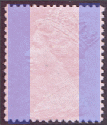I can understand why this happened (and still does) as catalogues do not give enough information on this subject. The majority of specialised catalogues just state that "all short and inset bands must be clear of the perforations", which to my mind sends out a wrong message that any shift that is clear of the perfs is good enough to qualify.
I prefer the Deegam criteria for these listings as it is precise and plain. In his handbook Douglas Myall has tried to educate collectors and dealers that a perforation shift only gives the illusion that stamps have a phosphor shift. Only perfectly centred stamps qualify for listing in his handbook. Due to Douglas's research the editor of the MBPC (Modern British Philatelic Circle) has now adopted this same policy.
.gif)
.gif)
.gif)
Douglas writes " The test is: if the perforations had been where they should have been, would the phosphor still have missed them. If the answer is yes the shift will qualify for listing in his handbook".
In short Douglas also writes "To be clear of the perforations the gap between the edge of a phosphor bar and the centre of the perforation hole MUST be .45 mm (half the width of a hole ) or greater, as a phosphor shift to that extent is permitted anything less will not clear the perforations".
Please note: Not all phosphor shifts are errors. Certain printings exist from se-tenant and barcode booklets where the phosphor alignment was placed away from the perforations purposely, these as single stamps are still known as inset or short bands but the actual booklet panes are classed as interrupted phosphor. Perhaps myself , Larry or even Robert Bostock (hint hint Robert) could make this the topic of a future post.




6 comments:
Top marks for this post.
I won several lots on eBay which stated they were inset from the perforations, these were in fact perforation shifts. I conplained and got my money back.
James McFadden
I've always wondered, to be honest, why a proper phosphor shift, leading to inset bands, is collectable, but why a proper perforation shift, leading to the same thing, isn't. Both type of shifts lead to the same result, ie an inset band. I can understand perforation shifts shouldn't be advertised as being phosphor shifts, but I fail to see why the one shift is so important as to warrant catalogue entries, and the other isn't!
How's that for a controversial topic!
:-)
Varieties caused solely by badly-centred perforations should not have a place in any specialised catalogue. People can collect whatever they want but to sell such a stamp as if it were a genuine inset or short band stamp without disclosing its true nature is either ignorance or fraud.
Well, Seeker that's a fine point but I did state that perforation shifts should not be advertised or sold as phosphor shifts. I do still wonder, however, why you do say that a variety caused solely by badly-centered phoshphor cylinders does have a rightful place in catalogues and why a variety caused solely by badly-centered perforations does not. Same thing really, in my opinion. Both types lead to a variety, and perf shifts going through designs do warrant catalogue status too, so why not perf shifts that lead to an inset phosphor band?
Adrian, I think you raise a good point. But it may come down to what is more common, a perforation shift or a phosphor shift. At least with the older stamps it seems to be harder to find a well centered stamp than a perforation shift. But a phosphor shift is more difficult to find and therefore more valued.
Mark
I agree with Mark, stamps that are not centred correctly are many. On the other hand 100% phosphor shift errors are fewer.
It is up to any individual collector as what he wishes to spend his / her money on but I also feel that a nicely centred stamp displays better.
Post a Comment